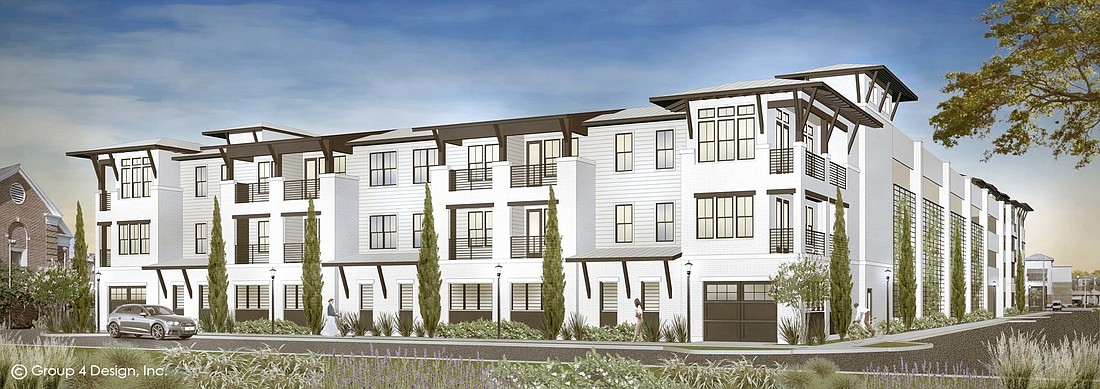
Two San Marco residents and the nonprofit Right Size San Marco Inc. are challenging the Park Place at San Marco apartment project.
The complaint is scheduled for a final hearing May 28-29, which could affect the project plans.
They filed the complaint March 26 with the Florida Division of Administrative Hearings alleging the proposed building height for the apartments and its 133-unit density violate the San Marco neighborhood’s overlay provisions set in the city Land Development Code.
City County enacted two ordinances in February allowing the height and density.
Florida Administrative Law Judge Suzanne Van Wyk will preside over the hearing via the Zoom videoconference platform, according to an April 17 filing confirming the hearing dates.
San Marco-based Corner Lot Development Group, led by Andy Allen, and Birmingham, Alabama-based Harbert Realty Services want to develop the 2.87-acre project at 2137 Hendricks Ave. The project is proposed on a section of South Jacksonville Presbyterian Church property.
San Marco residents Jonathan Livingston and Lakshmi Gopal and Right Size San Marco also filed a writ of certiorari on March 26 in the 4th Judicial Circuit Court in Duval County challenging the city’s rezoning of the property to a planned unit development.
A writ of certiorari orders a lower court to deliver its record in a case so that the higher court may review it, according to the Cornell Law School Legal Information Institute.
That proceeding is on hold until the appeal’s final decision, according to a Right Size San Marco Facebook post May 20.
The legal challenges temporarily delayed the ordinances from taking effect until a final decision is reached, according to a joint-prehearing stipulation document agreed to by both sides in the case.
Right Size San Marco, Livingston and Gopal retained St. Augustine-based Upchurch, Bailey and Upchurch attorney Sidney Ansbacher to represent them in their complaint.
Jacksonville-based attorney Paul Harden and Rogers Towers attorneys Emily Pierce, T.R. Hainline Jr. and Courtney Gaver represent South Jacksonville Presbyterian Church in the case, according to case documents.
Records show Tallahassee-based Hopping, Green & Sams attorneys Gary Hunter Jr. and Mohammad Jazil represent Harbert Realty.
The city will be represented by lawyers at the Office of General Counsel.
Harbert Realty has the development site under contract to purchase from the church. The site includes most of the block between Hendricks Avenue to the west, Mango Place to the east, Alford Place to the north and Mitchell Avenue to the south.
The development would carve out 2.09 acres of church property, leaving the main sanctuary building. A four-story, 133-unit apartment building is planned on the north side of the property and a two-story, three-level parking garage to the south.
Council voted 18-1 on Feb. 25 to enact Ordinance 2019-0750-E, a small-scale land use amendment for the development. It increased the maximum density allowed on the parcel to 133 units.
Council voted 17-1 to enact Ordinance 2019-0751-E, which rezoned the property to planned unit development, another project requirement.
Much of the public debate on the amended ordinances focused on the methodology used by the city Planning and Development Department to determine the building height.
By averaging the proposed 49½-foot-tall apartment building and 26.8-foot-tall garage, city Director of Planning and Development Bill Killingsworth told Council during the Feb. 25 debate on the final bills the project would comply with the zoning overlay, which caps buildings in the area at 35 feet.
According to state filings, Killingsworth has given a deposition in the legal challenge.
He based he decision on the calculated weighted average as the “sum of the height to the predominant roof line of that portion of a building divided by the length of that portion of a building divided by the overall length of permissible building within the minimum setback,” according to Ordinance 2019-0750-E.
Opponents alleged that because the weighted average calculation was proposed by the developer and not written in the overlay, it should not be allowed.
“The use, especially factoring the uniquely created site specific height policy, has an intensity that is dramatically out of scale and incompatible with the surrounding uses,” states the group’s petition for administrative hearing.
Killingsworth told the Council that while the overlay does state the maximum allowable height, it does not provide guidance on how it should be calculated.
City Assistant General Counsel Shannon Eller said during the February Council meeting that city code allows the planning director to interpret the zoning code.
She told Council member Randy DeFoor at the meeting that city attorneys are confident Killingsworth’s code interpretation could be defended in a legal challenge.
If the appeal is upheld, Council would be required to amend the approved legislation, an action that could impact the development.
Longtime San Marco resident and Group 4 At-Large Council member Matt Carlucci was the only Council member to vote against the rezoning and land use changes.
“This is a split community and these are people that we all care about. People on both sides care about people on both sides. Somehow, I think we can come together as a community again,” Carlucci said Feb. 25.